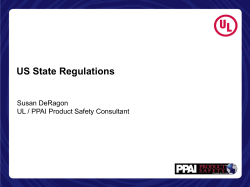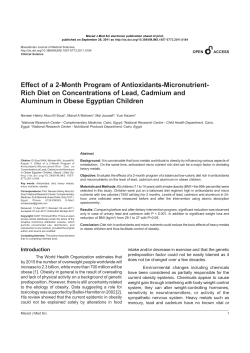
SB 1017 Department of Legislative Services Maryland General Assembly 2012 Session
SB 1017 Department of Legislative Services Maryland General Assembly 2012 Session FISCAL AND POLICY NOTE Senate Bill 1017 (Senator Dyson) Education, Health, and Environmental Affairs Environment - Cadmium in Children's Jewelry - Prohibition This bill extends from July 1, 2012, to July 1, 2013 the date by which a person is prohibited from manufacturing, selling, offering for sale, or distributing in the State children’s jewelry that contains cadmium at more than 0.0075% by weight. The bill takes effect June 1, 2012. Fiscal Summary State Effect: Extending the effective date of the prohibition is not expected to materially affect State finances or operations. Local Effect: Extending the effective date of the prohibition is not expected to materially affect local government finances or operations. Small Business Effect: Potential minimal increase in small retailer revenue for retailers that are allowed to sell children’s jewelry containing cadmium from their existing stock for an additional year. Analysis Current Law: Chapter 578 (HB 145) of 2011 prohibits a person from, on or after July 1, 2012, manufacturing, selling, offering for sale, or distributing any children’s jewelry containing cadmium at more than 0.0075% by weight. “Cadmium” means elemental cadmium and any compound or alloy that contains cadmium. “Children’s jewelry” means any jewelry (i.e., a charm, bracelet, pendant, necklace, earring, or ring), and any component of jewelry, designed or intended to be worn or used by a child younger than age 13. The prohibition does not apply to any toy regulated for cadmium exposure under the federal Consumer Product Safety Improvement Act of 2008. The Maryland Department of the Environment is authorized to adopt regulations to carry out the prohibition. Background: Cadmium, a naturally occurring element in soils and rocks, is a metal used in paint pigments, batteries, metal coatings, and plastics. According to the U.S. Agency for Toxic Substances and Disease Registry, cadmium is a known human carcinogen that can cause cardiovascular, developmental, renal, gastrointestinal, neurological, reproductive, and respiratory harm. According to the U.S Environmental Protection Agency (EPA), cadmium is a probable human carcinogen that may cause kidney disease and developmental defects. Since the passage of the federal Consumer Product Safety Improvement Act of 2008, which restricted the use of lead in children’s products, high levels of cadmium have been detected in children’s jewelry purchased from U.S. retailers. Most of these items were imported from manufacturers that began adding cadmium to their products as a substitute for lead. In May 2010, the U.S. Consumer Product Safety Commission (CPSC) announced a recall of 19,000 charm bracelets because of high levels of cadmium. In August 2010, EPA granted a petition requesting that (1) EPA require submission of health and safety studies related to cadmium and regulate the use of cadmium in toy metal jewelry; and (2) CPSC establish standards restricting cadmium in children’s products (and in metal jewelry in particular). According to EPA, the agency will propose a rule under the Toxic Substances Control Act to require the submission of health and safety studies related to cadmium. CPSC is currently developing exposure limits for cadmium. According to the National Conference of State Legislatures, 11 states (including Maryland) have considered 48 measures to curtail the use of cadmium. Eight states (Maryland, California, Connecticut, Florida, Illinois, Minnesota, New Jersey, and New York) have enacted restrictions on cadmium in children’s jewelry. Two states (Illinois and New Jersey) have restricted the use of cadmium not only in children’s jewelry but in children’s products generally. State/Local Effect: In the fiscal and policy note for HB 145 (Chapter 578) of 2011, Legislative Services advised that the prohibition could be enforced with existing resources and would have no effect on revenues. Thus, a one-year extension of the effective date of the prohibition is not expected to materially affect governmental finances or operations. SB 1017/ Page 2 Additional Information Prior Introductions: None. Cross File: None. Information Source(s): National Conference of State Legislatures, U.S. Agency for Toxic Substances and Disease Registry, U.S. Environmental Protection Agency, U.S. Consumer Product Safety Commission, Maryland Department of the Environment, Department of Health and Mental Hygiene, Maryland Association of Counties, Maryland Association of County Health Officers, Department of Legislative Services Fiscal Note History: mm/lgc First Reader - March 9, 2012 Analysis by: Jennifer A. Ellick SB 1017/ Page 3 Direct Inquiries to: (410) 946-5510 (301) 970-5510
© Copyright 2025





















